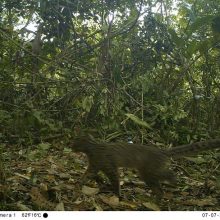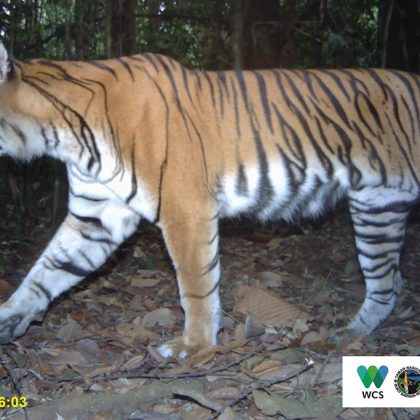Surprisingly high biodiversity found in Sumatran forest fragments
The paper ‘The conservation value of forest fragments in the increasingly agrarian landscape of Sumatra’ has been chosen by the Editor-in-Chief as the latest addition to the EC Perspectives Collection
 The rainforests in Sumatra are among the most biodiverse places in the world, but they face considerable anthropogenic pressure. Between 2000 and 2012, about 17.6% of the island’s primary tropical forest was cleared for agricultural use. One consequence of this deforestation is the creation of small, remnant forest patches across the Sumatran landscape. These fragments have been largely disregarded as wildlife habitat, and few studies have investigated whether and how these fragments are being used by wildlife.
The rainforests in Sumatra are among the most biodiverse places in the world, but they face considerable anthropogenic pressure. Between 2000 and 2012, about 17.6% of the island’s primary tropical forest was cleared for agricultural use. One consequence of this deforestation is the creation of small, remnant forest patches across the Sumatran landscape. These fragments have been largely disregarded as wildlife habitat, and few studies have investigated whether and how these fragments are being used by wildlife.
 To better understand how species are using forest fragments, we conducted camera trap surveys in and around Bukit Barisan Selatan National Park (BBSNP). BBSNP is the third largest protected area in Sumatra and contains some of the largest tracts of lowland tropical rainforest on the island; it is therefore important habitat for endangered species such as the Sumatran tiger, Sumatran rhino, Sumatran striped rabbit and Sumatran elephant. Despite its importance as integral habitat for these species, agricultural development around the park has accelerated in recent years, increasingly isolating the forests of BBSNP from other large protected habitats in Sumatra and raising concerns for the long-term viability of endemic Sumatran animals of BBSNP. However, small fragments of forest are often retained within the plantations, and we hypothesized that these may have value in allowing animals to utilize and move through the agricultural landscape. We decided to set up camera traps – which are triggered to take photographs whenever an animal walks by – within the national park itself, as well as in five surrounding forest fragments investigate how species were using these habitats.
To better understand how species are using forest fragments, we conducted camera trap surveys in and around Bukit Barisan Selatan National Park (BBSNP). BBSNP is the third largest protected area in Sumatra and contains some of the largest tracts of lowland tropical rainforest on the island; it is therefore important habitat for endangered species such as the Sumatran tiger, Sumatran rhino, Sumatran striped rabbit and Sumatran elephant. Despite its importance as integral habitat for these species, agricultural development around the park has accelerated in recent years, increasingly isolating the forests of BBSNP from other large protected habitats in Sumatra and raising concerns for the long-term viability of endemic Sumatran animals of BBSNP. However, small fragments of forest are often retained within the plantations, and we hypothesized that these may have value in allowing animals to utilize and move through the agricultural landscape. We decided to set up camera traps – which are triggered to take photographs whenever an animal walks by – within the national park itself, as well as in five surrounding forest fragments investigate how species were using these habitats.
 Because the fragments we surveyed were small (between 0.012 and 0.152 km2), we expected to mostly see small mammals. In contrast, we found 21 species of mammals in the fragments compared to 28 in the primary forest. We even saw several species of conservation concern, including Sumatran tiger, marbled cat, Asiatic golden cat, and Sunda pangolins in the fragments. Sunda pangolins are in serious decline throughout their range; their biggest threat is illegal hunting for their meat and scales, so it was noteworthy that we captured multiple photographs of pangolins in the two smallest fragments in areas completely surrounded by coffee plantations and humans.
Because the fragments we surveyed were small (between 0.012 and 0.152 km2), we expected to mostly see small mammals. In contrast, we found 21 species of mammals in the fragments compared to 28 in the primary forest. We even saw several species of conservation concern, including Sumatran tiger, marbled cat, Asiatic golden cat, and Sunda pangolins in the fragments. Sunda pangolins are in serious decline throughout their range; their biggest threat is illegal hunting for their meat and scales, so it was noteworthy that we captured multiple photographs of pangolins in the two smallest fragments in areas completely surrounded by coffee plantations and humans.
 While further fragmenting of primary forest should continue to be discouraged, the high levels of biodiversity that we found in the forest fragments indicates that they may have conservation value to certain mammal species, and that there may be benefits to preserving remnant forest fragments already present in the landscape. Moving forward, more research should be conducted into the role these habitats may play in landscape-level, multispecies conservation planning.
While further fragmenting of primary forest should continue to be discouraged, the high levels of biodiversity that we found in the forest fragments indicates that they may have conservation value to certain mammal species, and that there may be benefits to preserving remnant forest fragments already present in the landscape. Moving forward, more research should be conducted into the role these habitats may play in landscape-level, multispecies conservation planning.
A selection of photos from the camera traps in the fragments outside of BBSNP. Above and top left: Asiatic golden cat; top right: Sunda pangolin; bottom left: marbled cat; bottom right: Sumatran tiger.
The paper ‘The conservation value of forest fragments in the increasingly agrarian landscape of Sumatra’ is available do download for free as part of our EC Perspectives Collection






